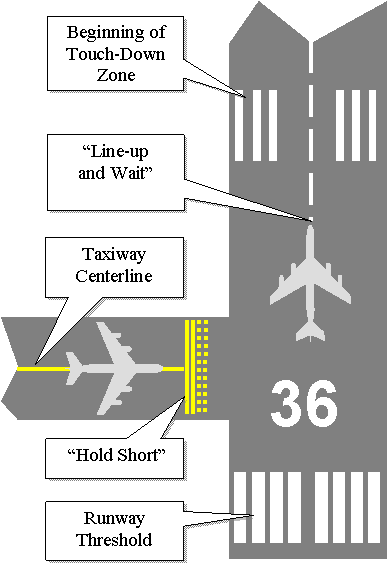|
Copyright ©2011 by Paul Niquette. All rights reserved.
|
|
Faced with increasing traffic loads, many airports are undertaking capital improvements to assure safe operations on the ground, in particular to eliminate runway incursions. For example, an up-to-date official airport layout for ORD shows the addition of new parallel runway (9L/27R) along with removal of an intersection (4R/32L with 10/28). Solvers may observe that both changes at ORD are relevant to the Position and Hold puzzle.
"Metroport Tower, Exemplair One-Two-Three-Four, Runway Three-Six,Notice the use of the word "departure" not "takeoff." That is part of a set of changes in radio phraseology mandated by the FAA in 2010 as a consequence of unsafe incidents on the ground, including the largest tragedy in aviation history, the 1977 Tenerife Disaster. As lamented by the author back in 2002, "Pilots still talk 'half-duplex' on party lines. A plumber's pocket pager applies more sophisticated technology than the most advanced avionics to be found in airliners."No wonder, then, the spoken phrase "ready for takeoff" can get inadvertently 'stepped on' by a simultaneous transmission and misunderstood upon reception as "cleared for takeoff," which happens to be the clearance most eagerly sought by the pilot of an idling airliner consuming fuel on the taxiway with a full load of passengers. Occasionally, though, the pilot will hear... "Exemplair Twelve-Thirty-Four, hold short of Runway Three-Six."As a courtesy, the tower may add "...for landing traffic on three-mile final" or "...for traffic on [an intersecting runway]." In the first case, Runway 36 is obviously being used for both takeoffs and landings, which would be expected at airports with just one runway or when a parallel runway is unavailable. It is appropriate for the pilot to respond with... "Exemplair Twelve-Thirty-Four is holding short of Runway Three-Six." "Exemplair Twelve-Thirty-Four, Taxi Into Position and Hold, Runway Three-Six."TIPH has long been a controversial clearance, inasmuch as it authorized the pilot to taxi onto the active runway and stop, with a demonstrated potential for tragic consequences. The acknowledgment by the pilot for TIPH was supposed to be... "Exemplair Twelve-Thirty-Four taxiiing into position and hold Runway Three-Six."...but was most often informally abbreviated to... "Position and hold, Twelve-Thirty-Four."That phrase "position and hold, " which is the title of this puzzle, has been officially abandoned in favor of "line up and wait" (LUAW) for transmission by the control tower... "Exemplair Twelve Thirty-Four, line up and wait on Runway Three-Six."...and is supposed to be formally acknowledged by the pilot... "Line up and wait on Runway Three-Six, Exemplair Twelve-Thirty-Four."The intention is to obviate the potential confusion brought about by the presence of the word "hold" in two phrases with nearly opposite meanings: "hold short" (of the active runway) and "position and hold" (in the middle of the active runway).
A popular supposition is that LUAW saves time.Using the sketch on the right, let us try to estimate the answer to the following question:
Whether "holding short" on the taxiway or "lined-up and waiting" on the runway, the pilot will in due course receive some good news from the control tower: "Exemplair Twelve-Thirty-Four,
The most likely purpose for the "wait" is to allow time {1} for an aircraft that is taking off or landing on a crossing runway to clear the intersection, {2} for an aircraft departing ahead on Runway 36 to become airborne, or {3} for an aircraft that has previously landed on Runway 36 to decelerate and turn off onto a taxiway.
|

